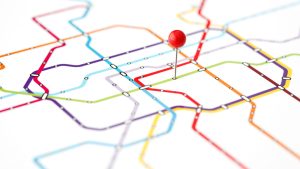This guide gives you 40 practical customer journey questions by stage, with interview and survey prompts you can drop into research, then map straight to your journey map to make fast, measurable improvements.
To understand how each part fits together, check the full overview of the customer journey stages and see what happens at every step.
TL;DR
Quick version: here’s how to use this guide.
👉🏻 Ask 5 focused questions per journey stage (8 stages = 40 total).
👉🏻 Capture answers on your customer journey map next to each touchpoint.
👉🏻 Tie each answer to a decision, metric, or change you’ll ship this month.
👉🏻 Re-run the same interview/survey quarterly to track improvement.
👉🏻 Prioritize fixes that improve the customer experience and drive customer loyalty.
Why Customer Journey Questions Matter At Every Journey Stage
You don’t need a 50-page playbook to improve the customer journey. You do need better questions. The right prompts at each journey stage reveal where customers get stuck, what proves your value, and which fixes create a unified customer experience.
In this guide, you’ll get 40 practical interview and survey questions organized by customer journey stages. Use them to fill your customer journey map, turn feedback into action, and improve the customer experience without guesswork.
What you’ll learn
- How to ask the right questions at each stage of the customer journey
- Which answers signal quick wins vs deeper fixes
- Simple ways to connect insights to your journey map and KPIs
How to Use This Guide
- Pick a product or service and list touchpoints on your journey map.
- For each stage below, ask the 5 prompts in interviews or customer surveys.
- Log answers directly on your customer journey map and tag themes.
- Prioritize changes that reduce friction, speed time-to-value, or drive customer loyalty.

40 Customer Journey Questions By Journey Stage
Each question follows this pattern: Ask → reveals → informs. Copy these into your interview script or survey tool.
1) Awareness: understand the customer’s first touch
Goal: match channels, hooks, and search intent.
- What exact words did you search before you found us, and which result did you click?
Reveals intent and SERP position, informs content and paid keywords. - On the first page you saw, what made you stay longer than 10 seconds?
Reveals hook quality, informs hero, and opening copy. - Which problem were you trying to solve today, in your own words?
Reveals jobs-to-be-done, informs messaging on the {{customer journey map}}. - Which channel first put us on your radar, and what convinced you to click?
Reveals channel fit, informs spend, and creative. - What almost made you bounce immediately?
Reveals friction, informs above-the-fold fixes.
2) Consideration: compare options with clarity
Goal: win the comparison and remove doubt.
- Which alternatives did you shortlist, and why were they on the list?
Reveals competitive set, informs positioning pages. - What information did you look for but couldn’t find right away?
Reveals content gaps, informs FAQs, and features pages. - What would help you make a faster decision today?
Reveals evidence needs, informs demos, trials, and proofs. - Which objection almost stopped you from moving forward?
Reveals risk, informs, guarantees, and social proof. - If you asked a colleague for advice, what did they say?
Reveals influence paths, informs enablement assets.
3) Decision: convert with trust
Goal: remove the last blocker at checkout or sign-up.
- What signal finally convinced you to try us, and where did you see it?
Reveals trust lever, informs CTA stack. - What was confusing or annoying in the checkout or sign-up process?
Reveals UX friction, informs form and flow changes. - Which price, plan, or term felt safest to start with, and why?
Reveals value perception, informs packaging. - Did you look for a guarantee, refund, or SLA?
Reveals risk handling, informs policies, and copy. - What would have made you purchase one step sooner?
Reveals missing accelerants, informs nudges.
4) Onboarding: speed time-to-value
Goal: help customers reach the first success moment.
- How long did it take to reach your first “this works” moment?
Reveals time-to-value, informs onboarding path. - What step felt unnecessary or confusing during setup?
Reveals friction, informs simplification. - Which help content or human touch would have made onboarding easier?
Reveals support gaps, informs guides and outreach. - If you could change the first-run checklist, what would you remove or add?
Reveals must-haves, informs in-app tips. - After day one, what did you want to do next but didn’t know how?
Reveals next best actions, informs, prompts, and emails.
5) Usage: build habits and value
Goal: deepen adoption for a better {{customer}} outcome.
- Which task do you repeat weekly, and how do you complete it now?
Reveals core workflow, informs feature, and docs. - Which feature is valuable but hard to find or use?
Reveals discoverability issues, informs navigation. - What manual workaround do you still rely on?
Reveals gaps, informs roadmap or automation. - When the product saves you time or money, what changed on your side?
Reveals value proof, informs case stories. - What would make you use us twice as often next month?
Reveals habit drivers, informs lifecycle nudges.
6) Support: reduce effort, raise trust
Goal: fix failure points and improve resolution.
- When something breaks, where do you go first and why?
Reveals help-center vs human preference, informs help IA. - What information should appear on a support page to avoid contacting us?
Reveals self-serve needs, informs articles, and searches. - Rate the last resolution speed and clarity. What’s one step to improve it?
Reveals SLA pain, informs staffing, and macros. - Did you repeat your issue across channels?
Reveals handoff gaps, informs journey management, and CRM workflows. - What would make you call the experience “easy”?
Reveals effort drivers, informs process simplification.
7) Retention: protect revenue
Goal: understand renewal triggers and churn risks.
- What outcome tells you the product is worth renewing?
Reveals value metric, informs success criteria. - What would make you cancel in the next 30 days?
Reveals risk, informs save plays. - Which message would convince you to stay if you were on the fence?
Reveals retention copy, informs lifecycle messaging. - If you downgraded or paused, what changed in your world?
Reveals external drivers, informs pricing and terms. - What would make you expand usage or add seats?
Reveals growth levers, informs success plans.
8) Advocacy: activate social proof
Goal: earn reviews, referrals, and community.
- What would make you comfortable attaching your name to a review?
Reveals blockers, informs review flow. - Which outcome would you proudly tell a peer about?
Reveals headline proof, informs case studies. - What’s the easiest way for you to refer us?
Reveals friction, informs referral design. - Where do you share product opinions, and what format do you prefer?
Reveals channels, informs outreach. - What perk or recognition would feel fair for a referral or testimonial?
Reveals incentive fit, informs advocacy program.
Map Your Findings To A Customer Journey Map
Turn answers into actions. For each touchpoint on your journey map or customer journey map:
- Note the friction in plain language.
- Assign an owner on the marketing team, product, or support.
- Define the change you’ll ship.
- Pick a metric to watch, like time-to-value, CSAT, or conversion.
This keeps your journey management focused and measurable.
Metrics That Matter At Each Journey Stage
- Awareness: CTR, qualified traffic, search intent match
- Consideration: content engagement, demo requests, and FAQ views
- Decision: checkout completion, errors per session, refund requests
- Onboarding: time-to-first-value, activation rate
- Usage: feature adoption, weekly active users
- Support: first-contact resolution, time to resolution, effort score
- Retention: renewal rate, expansion, downgrade reasons
- Advocacy: review volume, NPS verbatims, referral rate
Tip: visualize this in a simple dashboard. Heatmap the worst touchpoints first.
Optimize Touchpoints For A Better Customer Experience
- Small changes beat big promises. Start with:
- Shorter forms and clearer microcopy
- Objection-handling near CTAs
- In-app checklists that cut time-to-value
- Self-serve articles for the top 10 issues
- Proactive success emails with one next step
Consistency across channels builds customer relationships and drives customer loyalty.
Understanding The Basics: Mapping The Customer Journey
A customer journey map shows how people move from learning to buying to advocating. Include personas, key touchpoints, emotions, and the questions above. The goal is simple. Understand the customer. Improve the path. Repeat.
Next Steps To Improve The Customer Experience With Your Customer Journey Map
If you only do one thing this quarter, ask better questions. Use the 40 prompts, post the answers on your journey map, and ship one improvement per stage. That rhythm, repeated, will improve the customer experience, raise renewals, and turn quiet fans into loud advocates.
Next step: pick one stage where you’re weakest. Run 5 interviews and one short survey this week. Map the findings. Fix one blocker. Then move to the next stage.
Customer journey questions are organized here into 40 clear prompts across eight stages so you can diagnose friction, confirm value, and plan fixes with confidence. You’ll get interview and survey wording, guidance on logging answers to a customer journey map, and simple rules for turning insights into changes that improve the customer experience. We also outline stage-by-stage metrics, from time-to-value to renewal triggers, so you know what to watch as you iterate. Use the list to run quick interviews, pair results with your analytics, and prioritize one improvement per stage. The outcome is a cleaner path from awareness to advocacy, plus stronger retention and referrals.







